Home » Eyewear Gallery » Eyeglass Lenses
Eyeglass Lenses
Measurements Matter
Better vision through technology
We use the latest high tech digital measurement devices to ensure your lenses give you the best vision. Simply put, more precise measurements mean better optics and sharper clarity.
This modern tech is similar to motion capture technology used in the movie industry to create realistic animations. By adapting this technology to measuring the way your eyes sit and move in your frame, we can give you quality optics and the clearest and most comfortable vision possible.
This tech, combined with the expert knowledge of your optical consultant at Mission Eye Care will ensure you are seeing to your fullest potential.
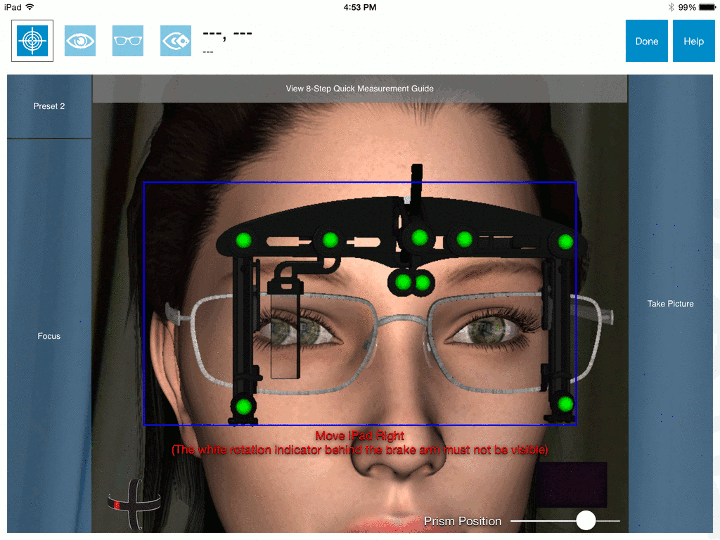
Types of Lenses
Choosing frames is the fun part, but your lenses are the most important factor for clear comfortable vision. There are 3 main considerations when choosing lenses.
- Lens Type – single vision, anti-fatigue, office, progressive, transitions, polarized and driving specific
- Lens Material – CR-39, polycarbonate, trivex, 1.6, 1.67, 1.70, 1.74. Each have different thicknesses and levels of optical distortion
- Coating – there various types and qualities. Coatings and films affect the level of glare, UV protection, blue-light filtering, scratch resistance, smudge resistance, ease of cleaning and more
Single Vision Lenses
This is the most simple type of lens, providing clear vision at a single focal distance. For most people, these lenses are made for either far, computer, or reading viewing distance. We can categorize these lenses into 2 types, conventional and digital.
Conventional Lenses
These lenses are generally inexpensive since they are mass produced in a variety of common powers. For ideal vision, they must be centered precisely to your pupils in a well fitting frame that does not sit far from the eyes. Proper centration is impossible without measuring how the frame sits relative to your eyes. The horizontal distance between your eyes (PD) is not enough to properly center the lens, often leading to eye strain and peripheral blur when fitting measurements are not taken in person. When fit properly, these lenses can provide adequate vision.
Digital Lenses
These lenses provide superior vision from edge to edge with minimal to no distortion. They also look better as they are up to 16% thinner and 49% flatter than conventional lenses when ideally fitted. A proper fitting involves the following measurements:
- Monocular PD – the distance from the centre of your nose to the centre of the pupil on each side
- OC height – the vertical distance from the bottom of the frame to your pupil
- Frame wrap – the curvature of the frame
- Pantoscopic tilt – the tilt angle of the bottom of your frame relative to the front plane of the face
- Vertex distance – the distance from the back of the lens to the front of your eye
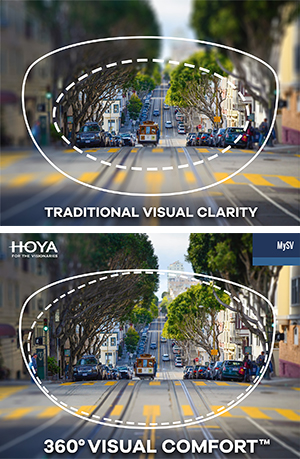
Anti-fatigue Lenses
In today’s world, we are using our eyes up close more than for distance, resulting in a huge amount of stress on our focusing muscles. This leads to eye strain, fatigue and dry eyes from reduced blinking.
An anti-fatigue lens aims to reduce the strain on the focusing system using a “near activated zone” towards the bottom, adjusted for focusing up close. This can reduce eye fatigue and allow for more comfortable vision when viewing digital devices. Similar to above, accurate measurements are critical to ensure proper placement of this near zone.
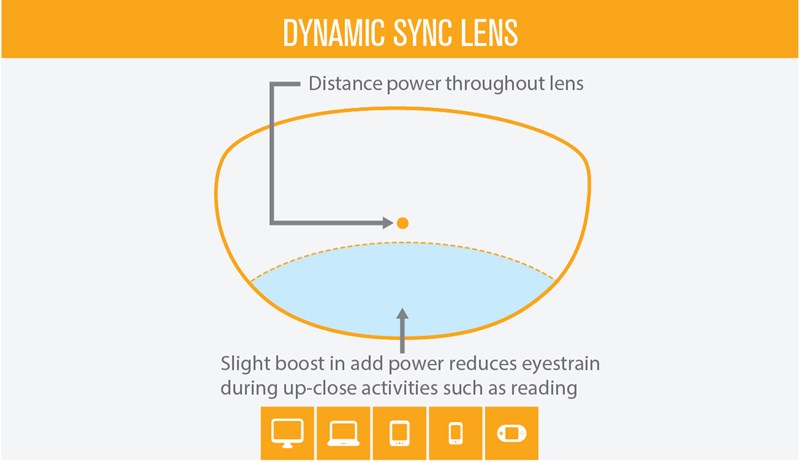
Progressives
Progressive lenses are designed for clear distance viewing with progressively more reading power the further down you look. As with all lenses, accurate measurements are essential for correct placement of your distance, intermediate and reading zones. Proper choice of a well-fitting frame and a task specific lens design is also important to ensure a wide field of near vision without having to hunt for the sweet spot.
The lens design chosen will be based on how you use your eyes. Every design is different, with zones and power transitions suited for different visual demands. Some are better for drivers, other better for computer users. Whichever design is chosen, higher end lenses will have wider fields of clear vision and less “swim.” This is because they are manufactured using complex algorithms to optimize your prescription for points further from the centre. These lenses are also available in transitions and polarized sunlenses.

Office Lenses
Office lenses are the ideal solution for computer users.
They are designed to allow clear computer viewing without tilting the head upwards. Unlike progressives where the computer focal point is below centre, the focal point for computer in an office lens is directly ahead. Above this point there is slightly less power to allow you to see a few metres across a room, and below this point is added reading power to allow you to read items up close and see your keyboard.
These variable near focus lenses have minimal side blur and allow wider fields of view than progressives. They can be customized for a slightly farther distance for those that need to see clients or get up from their desks more often, but are not suitable for driving or far distance viewing.
We generally advise a blue light coating on these lenses which further reduces the eye strain. Since blue light is the most out of focus wavelength, eliminating or reducing the amount of this light will allow for clearer and more accurate focus.
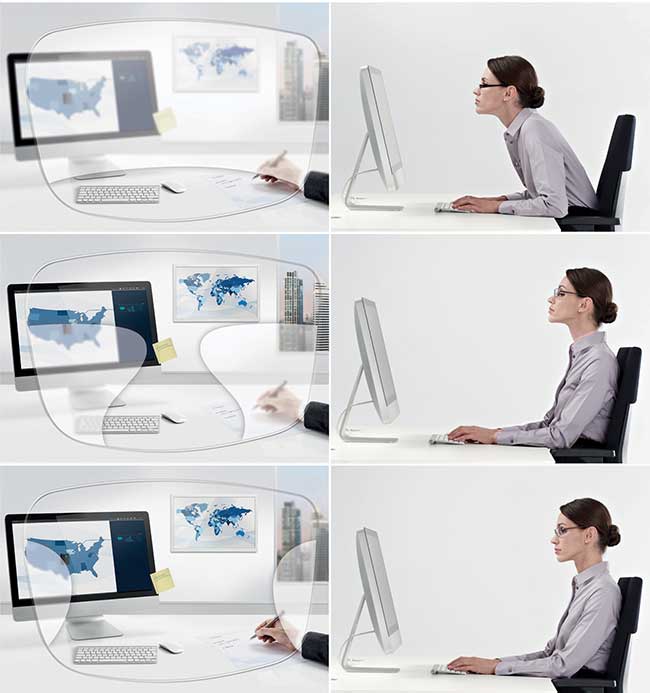
Driving Lenses
These lenses are designed specifically for glare reduction and enhanced contrast when driving. They have an coating specifically tuned to substantially reduce glare from modern LED and HID headlights as well as street light glare and light scatter from rain and fog. They also have a filter to enhance low light contrast and brighten up the vision at dawn and dusk.
The lenses are offered in both single vision and progressive lens designs.
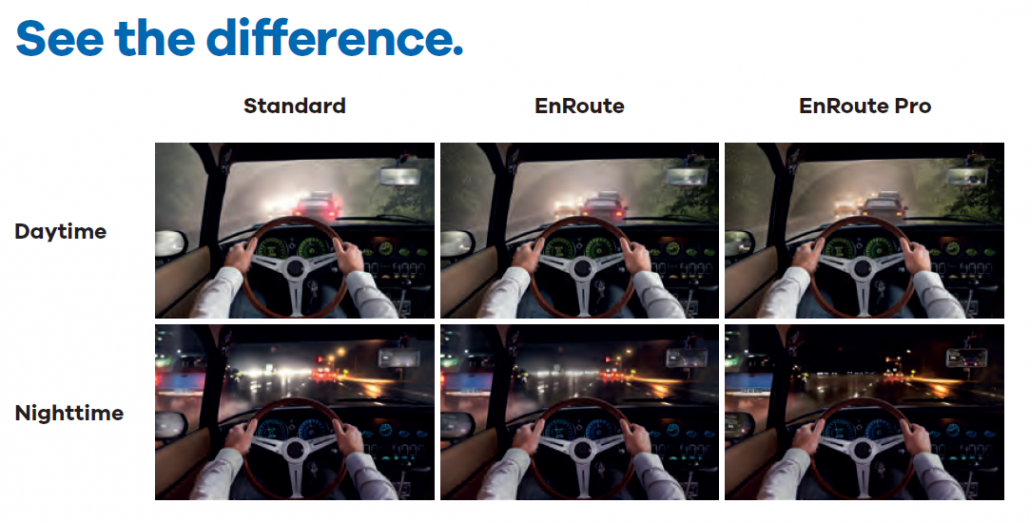
Transitions and Polarized Lenses
Transitions™ or photochromic lenses are clear indoors and turn dark outdoors in response to UV or short wavelength light. They darken quickly, provide 100% UV protection, and go clear after about a minute indoors. They are also available in a darker and more fast acting version that works behind a car windshield. They are also now available in up to 6 colors!
Polarized lenses are a true sunglass lens with an internal film that reduces reflected light (glare) from horizontal surfaces. Like the above, there are various color enhancing options as well as tints specific for driving, golfing, fishing, water and winter sports. These lenses are superior to standard tinted lenses which do not reduce reflected glare. Ask us for options best suited for you!

Coatings
Almost all lenses nowadays have anti-glare coatings but they are NOT created equal.
Conventional single vision lenses come pre-coated from the factory. These coatings can vary in quality, which is often price dependent. Lower end lenses have few layers of anti-glare and poor scratch resistance. Since each layer is specific for eliminating glare of a certain wavelength, more layers means better glare reduction. Good quality anti-glare coatings will have almost no reflection and transmit over 99.5% of visible light!
Better lenses also have oil-resistant, water-resistant and anti-static coatings to make them easier to clean. To test if your lenses have these higher end coatings, put a sticky note on them and see if it sticks (it shouldn’t)! They should also bead up when you try to write on them with marker.
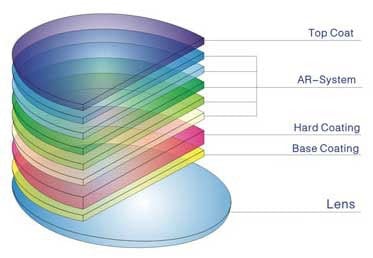
Blue Light Coatings
These lenses are designed to reflect (filter) short wavelength blue light from LED devices. Here are some reasons to consider these coatings:
- Blue light affects your circadian rhythm. When you look at digital devices, especially towards bedtime, the body wants to stay awake as if it were daytime. Blocking this light may improve sleep quality.
- Blue light focuses in front of the retina. Blocking this light reduces blur, making images sharper. In many cases, the eyes stay more relaxed, and the blink rate improves. This can help reduce dry eyes and improve comfort after long hours spent on screens.



